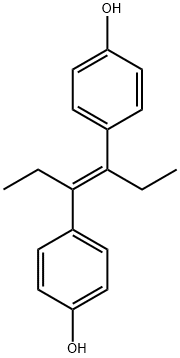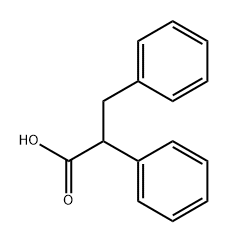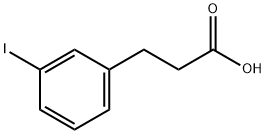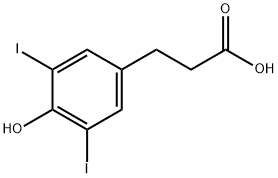Pheniodol
- CAS NO.:577-91-3
- Empirical Formula: C15H12I2O3
- Molecular Weight: 494.06
- MDL number: MFCD00021711
- EINECS: 209-417-4
- SAFETY DATA SHEET (SDS)
- Update Date: 2023-05-04 17:34:40

What is Pheniodol?
Originator
Priodax,Schering,US,1943
Definition
ChEBI: Pheniodol sodium is a stilbenoid.
Manufacturing Process
Dextro-β-(4-hydroxyphenyl)-α-phenylpropionic acid (24 g) was dissolved in
630 ml of water containing 8.0 g of sodium hydroxide, and, with good stirring
at 25°C, 51 g of iodine and 51 g of potassium iodide dissolved in 240 ml of
water was added dropwise over a period of 30 minutes. During this period
another 8 g of sodium hydroxide dissolved in 60 ml of water was added in
order to keep the reaction mixture alkaline to phenolphthalein. Stirring was
continued for 15 minutes longer. The resulting solution was made acid to
Congo red with concentrated hydrochloric acid, and about 5 g of sodium
bisulfite was added to partially decolorize the resulting slurry. The solid was
collected by filtration and washed well with water.
The crude iodinated acid was then dissolved in 500 ml of 95% alcohol, 10 g of
dimethylaminoethanol was added, the solution was decolorized with activated
charcoal and filtered at 70°C. After keeping the filtrate for several hours at
5°C. the heavy crystalline precipitate which formed was collected by filtration
and washed with acetone. The mother liquors were concentrated to 150 ml
and cooled to give a second crop which was further purified by
recrystallization from 50 ml of 95% alcohol. In this way a total of 36.0 g of
dimethylaminoethanol salt of dextro-β-(3,5-diiodo-4-hydroxy)-α-
phenylpropionic acid, MP 151° to 153°C, was obtained. The melting point of
the dimethylaminoethanol salt of unresolved β-(3,5-diiodo-4-hydroxy)-α-
phenylpropionic acid was 142° to 144°C.
The pure dimethylaminoethanol salt was dissolved in 400 ml of 50% acetic
acid at 90°C and then cooled to 5°C. The solid which precipitated wascollected by filtration, washed with water, cold 50% acetic acid and finally with
low-boiling petroleum ether. After drying in vacuo there was obtained 24 g of
hydrated dextro-β-(3,5-diiodo-4-hydroxy)-α-phenylpropionic acid, MP 80° to
85°C.
brand name
Priodax (Schering).
Therapeutic Function
Diagnostic aid (radiopaque medium)
Safety Profile
Poison by intravenous route. Moderately toxic by ingestion, intraperitoneal, and subcutaneous routes. When heated to decomposition it emits very toxic fumes of Ií.
Properties of Pheniodol
| Melting point: | 164°C |
| Boiling point: | 439.0±45.0 °C(Predicted) |
| Density | 1.9344 (estimate) |
| pka | 4.12±0.10(Predicted) |
| CAS DataBase Reference | 577-91-3 |
Safety information for Pheniodol
Computed Descriptors for Pheniodol
New Products
Tert-butyl bis(2-chloroethyl)carbamate 4-Methylphenylacetic acid N-Boc-D-alaninol N-BOC-D/L-ALANINOL 3-Morpholino-1-(4-nitrophenyl)-5,6-dihydropyridin- 2(1H)-one Furan-2,5-Dicarboxylic Acid Tropic acid 1,1’-CARBONYLDIIMIDAZOLE DIETHYL AMINOMALONATE HYDROCHLORIDE R-2-BENZYLOXY PROPIONIC ACID 1,1’-CARBONYLDI (1,2-4 TRIAZOLE) N-METHYL INDAZOLE-3-CARBOXYLIC ACID (2-Hydroxyphenyl)acetonitrile 4-Bromopyrazole 5-BROMO-2CYANO PYRIDINE 5,6-Dimethoxyindanone 5-broMo-2-chloro-N-cyclopentylpyriMidin-4-aMine 2-(Cyanocyclohexyl)acetic acid 4-methoxy-3,5-dinitropyridine 2-aminopropyl benzoate hydrochloride 1-(4-(aminomethyl)benzyl)urea hydrochloride diethyl 2-(2-((tertbutoxycarbonyl)amino) ethyl)malonate tert-butyl 4- (ureidomethyl)benzylcarbamate Ethyl-2-chloro((4-methoxyphenyl)hydrazono)acetateRelated products of tetrahydrofuran








You may like
-
 2033-24-1 98%View Details
2033-24-1 98%View Details
2033-24-1 -
 1975-50-4 98%View Details
1975-50-4 98%View Details
1975-50-4 -
 2-HYDROXY BENZYL ALCOHOL 98%View Details
2-HYDROXY BENZYL ALCOHOL 98%View Details
90-01-7 -
 2-Chloro-1,3-Bis(Dimethylamino)Trimethinium Hexafluorophosphate 221615-75-4 98%View Details
2-Chloro-1,3-Bis(Dimethylamino)Trimethinium Hexafluorophosphate 221615-75-4 98%View Details
221615-75-4 -
 61397-56-6 CIS BROMO BENZOATE 98%View Details
61397-56-6 CIS BROMO BENZOATE 98%View Details
61397-56-6 -
 14714-50-2 (2-Hydroxyphenyl)acetonitrile 98+View Details
14714-50-2 (2-Hydroxyphenyl)acetonitrile 98+View Details
14714-50-2 -
 118753-70-1 98+View Details
118753-70-1 98+View Details
118753-70-1 -
 733039-20-8 5-broMo-2-chloro-N-cyclopentylpyriMidin-4-aMine 98+View Details
733039-20-8 5-broMo-2-chloro-N-cyclopentylpyriMidin-4-aMine 98+View Details
733039-20-8